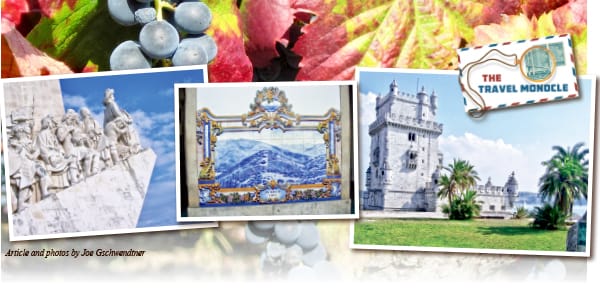Portugal: One Country, Many Flavors

Article and photos by Joe Gschwendtner
Portugal was on top of the world in the 16th century. Capitalizing on the skill of her navigators, their discoveries and trade routes, untold wealth flowed into the national treasury. It was a golden age in which (King) Manuel I and his explorers set the pace for all of Europe. Though born Italian, Christopher Columbus spent his formative years in Madeira and Lisbon learning what he could from seasoned Portuguese seafarers.
Portugal itself packs a cultural wallop with architecture, cuisine, customs, and art. In her “Golden Age” a unique ornamental building style evolved. Moorish influenced and characterized by elaborately carved masonry flourishes, the Manueline style is showcased in many palaces, castles and churches throughout the country.
The sea played a key role in shaping her destiny. Thus, broader Portuguese cuisine and culture is an amalgam of the empire. Considering its global reach, it is understandable that sailors and then families would be influenced by African, Indian, and far eastern lifestyles. Portuguese food does not disappoint. Fresh fish, even inland, is almost always on the menu. Bacalhau (cod) is a national favorite. Meat and zesty sausage dishes are abundant. Served with beans or rice, accompanying sauces reflect the influences of a once far-flung empire.
Over the last millennium, Portuguese artisans have uniquely enhanced their country with handcrafted “Azulejos,” tiles displayed in all fashions and places of public and private life. To truly experience Portugal without appreciating the vibrancy these tiles impart to the everyday experience is impossible. A trip to Portugal to simply absorb this artistry alone would be money well spent.
For the luxury or mature traveler, Portugal’s state-run Pousada booking system offers accommodation options featuring extraordinary comfort in historic, museum-like venues. The New York Times calls these venues “dream places.” At last count, there were 32 facilities, spaced evenly throughout the country. All can be viewed conveniently on the national website. Indeed, there is a small subset of sophisticated travelers who plan their itineraries based solely on Pousada availability.
Agriculture is a mainstay of the Portuguese economy. Half the world’s cork is grown in Portugal. Trees are harvested every nine years for their cork bark with some surviving up to 300 years. If wines are your pleasure, note that Portugal is the fifth largest wine exporter in the world. Ancient Carthaginians and Phoenician civilizations first introduced the grape to Portugal, but it was her climate and terrain, particularly in the Douro Region that assured the industry would flourish.
One may bisect the country using the Tagus River that flows from Spanish highlands westward and through Lisbon. North of the Tagus it is green country, higher and more forested than the flatter more agricultural south. Making a two Portugal distinction, the remaining two articles will be framed accordingly, adding the island of Madeira and the Algarve into the southern mix.
Without exaggeration, it may be safely said that Portugal offers fascination from and for the ages. Culturally dense, colorful, and self-drivable, it is a tree laden with fruit, ready for the picking. In the larger universe of travel, it can be your Iberian “Whitman’s Sampler.” Begin planning now: autumn and the harvest season are idyllic!